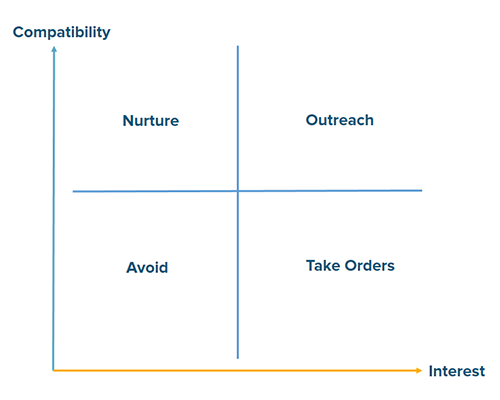
Most professional services firms have similar business development characteristics:
- Relatively high customer lifetime values
- Relatively low number of deal transactions
- Limited business development resources
With the exception of the multinationals, most professional services firms don't have dedicated sales professionals. Consultants and principals are responsible for acquiring new business, managing service delivery and managing the business. These characteristics make it important for professional services businesses to dedicate limited business development resources to high-probability opportunities.
The first step in focusing business development opportunities on the right opportunities is to choose target market niches for which you have expertise and experience. By creating marketing content for target niches that answer their unique questions and help them understand how to solve them, you will be well positioned for growth.
But to focus on the right opportunities, it's just important to understand which opportunities not to waste your time on. That's why high-growth firms excel at lead scoring and lead qualification.
In the post below, we will explore lead qualification in general and professional services lead scoring using HubSpot's Professional Marketing Hub.
The 2 components of lead qualification
There are 2 components of assessing whether leads have the potential to be high-percentage sales opportunities.
- Demographic qualification measures how closely a lead matches your ideal customer profile definition.
- Engagement qualification measures the quantity and quality of a lead's interactions with your sales and marketing efforts.
When you're qualifying for demographics, you look at things like:
- The lead's position in her organization and the role she will play in a purchase decision. Someone in a C-suite position who is responsible for the budget from which you're services would be purchased ranks highly in your qualification process.
- The lead's industry and how it fits with your ideal customer profile definition. For example, if you're targeting accounting firms and the lead is in the retail industry, you have a poor fit to your ideal customer profile.
- The geographic location is also an important demographic factor. For many of us, geography is used as a disqualifying criteria. Those of us practicing content marketing generate leads from all over the world. In our case, we work with customers in the US and Canada, so we use the leads IP country to make sure we're expending business development resources on viable prospects.
These are just a few of the demographic factors that may come into play, but these are used in most circumstances.
When evaluating engagement with your business development efforts, consider these elements:
- Views of website pages that may indicate a buying intent like pricing pages and services/solutions pages.
- Email engagement including opens and clicks. This in itself doesn't indicate a buying intent, but a high engagement with someone with a high demographic fit should be taken into account.
- Engagement with your content marketing. Which blog posts and webinars has the lead read/viewed? Which premium content offers has the lead downloaded?
- Requests for consultations and/or demos. These are high buying intent offers; if someone has requested a consultation or a demo, it indicates an interest in your services.
Here is an illustration that shows how to evaluate leads based on these two criteria and actions to take based on how they comport with your qualifying criteria.

To summarize the 4 possible outcomes:
- High compatibility, high interest - these are leads that should be contacted as soon as possible to determine if there is a sales opportunity
- High compatibility, low interest - these are leads that should be nurtured with helpful content and email marketing.
- Low compatibility, high interest - these are leads that should either be referred to someone who can help them or taken on as customers if they want to buy. You need to take these customers on with caution - if they don't fit into your customer service model, they may be more trouble than they're worth.
- Low compatibility, low interest - don't waste your time with these leads.
Lead Scoring Fundamentals
The first thing to understand about lead scoring is that it's an iterative process. It's important to optimize your process based on experience and feedback from sales.
But where should you start? How should you assign point values to the various demographic factors and interactions with your marketing campaigns?
I suggest starting by identifying the most sales ready action your prospects could take. Most professional services firms offer a consultation or a demo as part of their marketing process. Assign 10 points to that sales ready activity. In our case, you will see a button for "Schedule a Consultation" at the top right hand corner of this page. We assign 10 points to a lead that request a consultation. All of the other activities should be assigned points relative to that sales ready activity.
For example, how does a view of your pricing page or your solutions page relate to the 10 points assigned to a consultation? How about an email open or other indicators of engagement with your marketing process? While there will be some guesswork involved, it will be educated guesswork. Clearly you wouldn't assign 5 points to an email open if you're assigning 10 to a request for a consultation. Maybe a more appropriate way to score email engagement would be to assign points if someone opens 3 or more emails.
As mentioned earlier, your first pass at lead scoring is just that - a first pass. As you apply lead scoring to actual suspects and prospects, you will see how accurate your first pass was. Listen to feedback from your sales team to see which leads they think are good ones. Then analyze that lead's actions and demographics to identify common elements.
It's important to realize that they more data you have, the better your lead scoring will be. There are generally two sources of data:
- Data that comes from form fills and tracked activity on your website; and
- Data that your sales team adds to contact records.
For example, you will note the form at the bottom of this blog posts asks 3 demographic questions:
- The person's role at their company
- The industry in which the person works
- Are they a HubSpot customer?
If someone completes the form, we capture this date for lead scoring and qualification. But what if it's someone that we meet at a networking event or through email prospecting? In that case, it's the salesperson's responsibility to capture that information in HubSpot. You will see below a process to make it easy for the salesperson to make that an easy part of their work process.
Lead scoring in HubSpot
Lead scoring in HubSpot is found in a property called HubSpot score. Here is a video with some of the basics of lead scoring in HubSpot.
The about pane in the HubSpot contact record plays an important role in your sales process. It can be modified to include the important data elements of a contact record in a quick, easy to view format for salespeople. It also allows them to easily update important information in contact records. Here is a video on the about this contact section in the HubSpot contact record.
Using lead qualification and scoring in your sales process
The primary goal of lead scoring is to enable you to prioritize time and resources on the leads that are most likely to become customers. Most professional services practitioners do more than just sell - we manage people, we manage customer relationships and we manage our businesses. We need to focus our selling time and resources on high-percentage opportunities.
The first way to use lead scoring and qualification is to identify leads that are "marketing qualified." In our case, this means identifying leads that play the appropriate role in industries that we target. We use marketing automation to identify marketing qualified leads based on form submissions. In our case, we generate roughly 100 inbound leads per month and 25-35 of them are marketing qualified. We want to work on those 25-35 marketing qualified leads and not waste time on the rest. By using marketing automation and lead scoring, we can identify and pass on the leads for the next round of qualification and action.
Marketing qualified leads are then passed on for sales review. This involves human review of LinkedIn profiles and company websites to determine if the lead warrants further action and can be classified a sales qualified lead. We can then initiate the next action, whether it be a phone call or an email outreach.
Lead scoring and lead qualification keeps us working on the best leads and not wasting time on someone in an industry or country that we just can't help.
The principles outlined above can be modified for just about any professional services sales process. If you'd like to discuss how you can use lead scoring in your business, schedule a lead scoring consultation here.







